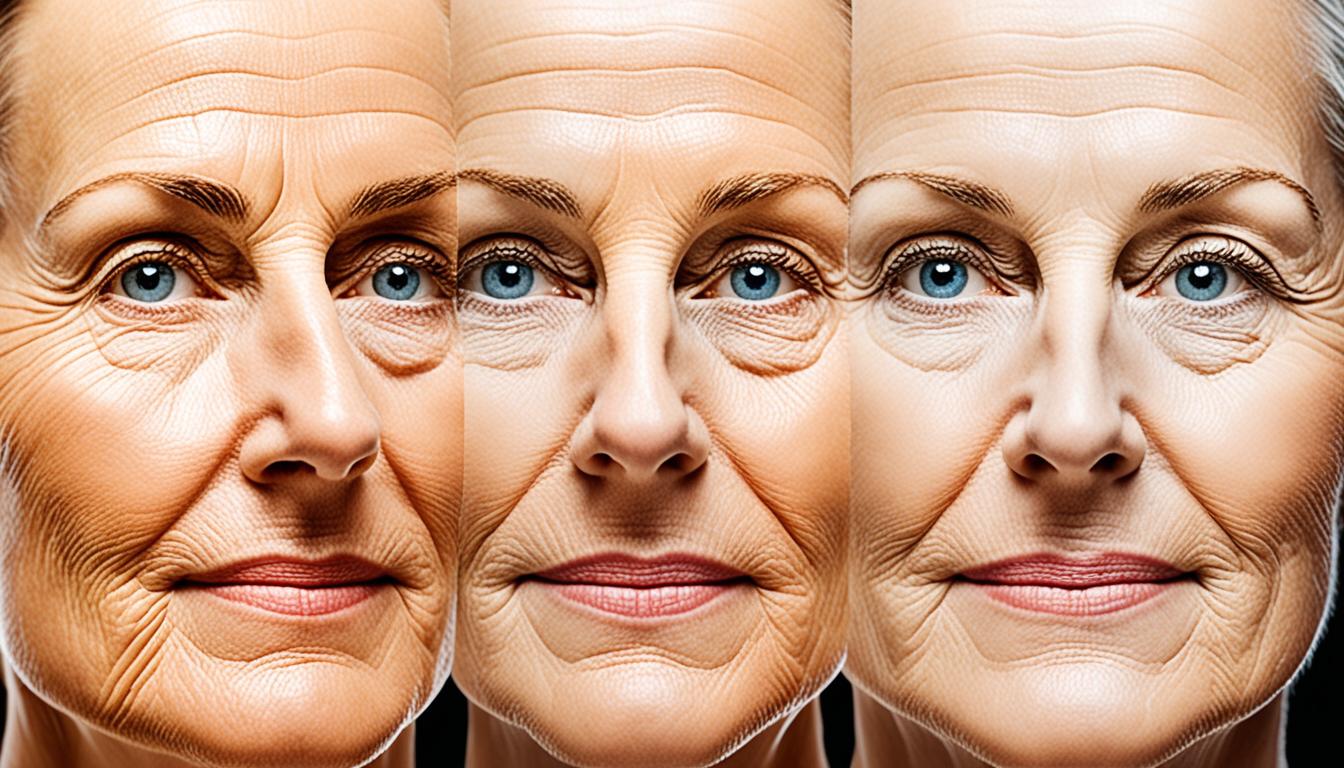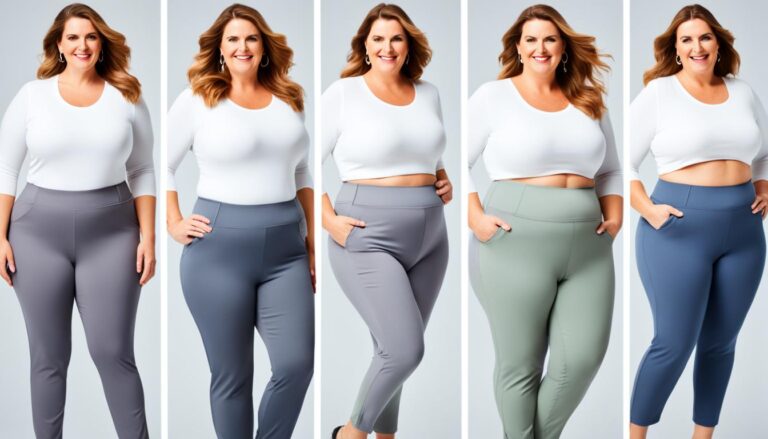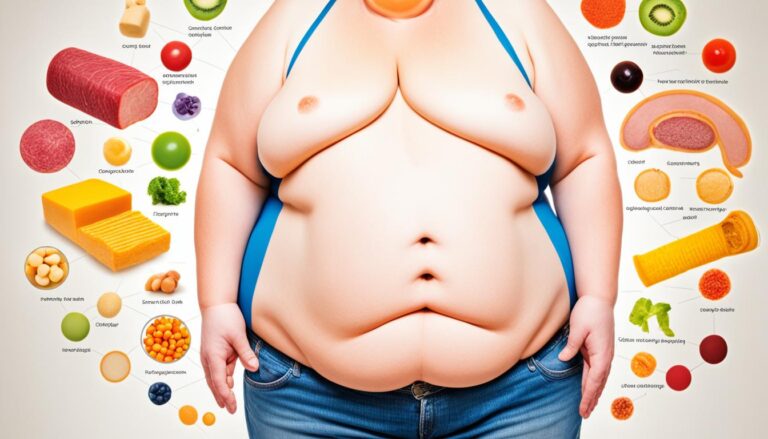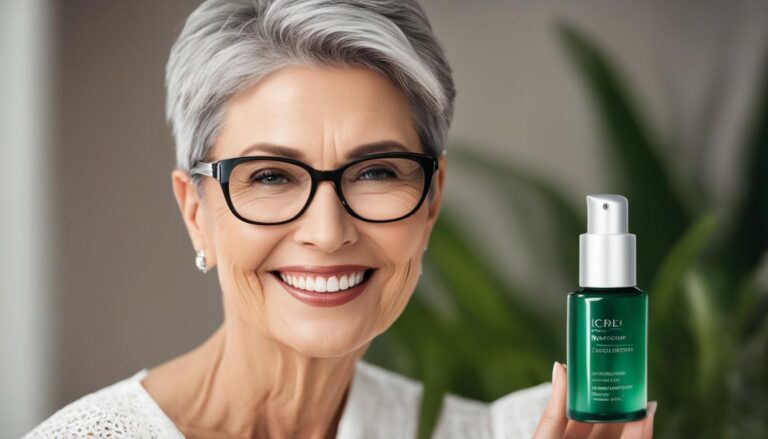Does your face change at 50?
As you approach your 50th birthday, you may start to wonder what changes await you. One of the most noticeable changes that many people experience is in their appearance. But what exactly happens to your face as you reach this milestone?
Signs of aging become more apparent as you enter your 50s. Your skin may lose its firmness and elasticity, leading to sagging cheeks, jowls, and a less defined jawline. Wrinkles and fine lines become more pronounced, and dark spots and blotches may appear due to sun exposure over the years. The skin around your eyes develops crow’s feet and wrinkles, and your eyebrows and eyelashes may turn gray.
But that’s not all. The underlying structures of your face also undergo changes. The loss of fat volume leads to a hollowing effect, especially in the cheeks and eyes, making you look older. The bones in your face may even change, impacting the overall shape and structure. And let’s not forget about the impact on specific facial features like your lips, nose, and mouth.
Curious to know more about the changes that occur in your face at 50? Keep reading to discover the aging process and its effects on your appearance.
Key Takeaways:
- As you reach your 50s, your face may undergo several changes that are signs of aging.
- Your skin may lose its firmness, leading to sagging, wrinkles, and dark spots.
- The loss of fat volume can result in a hollowing effect in the cheeks and eyes.
- The bones in your face may change, impacting your overall facial shape and structure.
- Specific facial features like your lips, nose, and mouth can also be affected by aging.
Now that you have an idea of what to expect, let’s dive deeper into the aging process and explore the causes behind these changes in the next section.
The Aging Process: What Causes Changes in the Face
As you reach your 50s, you may start to notice significant facial changes. These changes are part of the natural aging process and can be influenced by various factors. Let’s explore what causes these changes in the face and how they manifest.
One of the primary factors contributing to facial changes at 50 is genetics. Your genetic code plays a role in how well your face ages. Some individuals may have genes that make them more prone to certain signs of aging, such as wrinkles or sagging skin.
Additionally, external factors like diet, lifestyle, maintenance, and care can impact the aging process. Poor dietary choices, excessive sun exposure, stress, and environmental factors like pollution can accelerate facial aging. The choices you make in terms of skincare routines and lifestyle habits can greatly influence how your face changes over time.
Let’s break down the specific changes that occur in the face as you age:
1. Skin Sagging and Loss of Volume:
As you age, your skin gradually loses elasticity and firmness, leading to sagging. This is due to the natural decline in collagen and elastin production. Additionally, the underlying layer of fat in the face diminishes, resulting in a loss of volume and plumpness.
2. Wrinkles and Signs of Wear and Tear:
The skin on your face shows signs of wear and tear from intrinsic aging processes, sun damage, and other environmental factors. Wrinkles, fine lines, and uneven skin tone become more prominent with age.
3. Changes in Facial Bones:
Facial bones undergo changes with age, including bone loss and changes in angles. These changes can lead to a more sunken appearance of the eyes, a drooping nose, and a retraced jawline.
4. Loss of Facial Muscle Tone:
The muscles in your face lose volume, strength, and elasticity over time. This contributes to sagging cheeks, droopy eyelids, and the appearance of a “turkey neck.”
5. Fat Redistribution:
Facial fat loses volume and redistributes downward as you age, resulting in the formation of jowls around the chin and jawline. Thin and translucent skin can exacerbate the appearance of fat clumping in the lower face.
To help you visualize these changes, below is a table summarizing the key facial changes and their causes:
| Facial Changes | Causes |
|---|---|
| Skin Sagging and Loss of Volume | Decreased collagen and elastin production, loss of facial fat |
| Wrinkles and Signs of Wear and Tear | Intrinsic aging, sun damage, environmental factors |
| Changes in Facial Bones | Loss of bone mass, changes in bone angles |
| Loss of Facial Muscle Tone | Decreased muscle volume and elasticity |
| Fat Redistribution | Decreased facial fat volume, thin and translucent skin |
It’s important to note that while these changes are a natural part of the aging process, there are various options available for facial rejuvenation. Non-surgical treatments like injectable fillers and skin tightening procedures can help restore lost volume and improve the overall appearance of the face. Surgical interventions like facelifts can provide more comprehensive and long-lasting results.
Understanding the causes behind facial changes at 50 can empower you to make informed decisions about your skincare and explore suitable treatments to maintain a more youthful appearance.
The Skin: Sagging and Its Causes
As you reach the age of 50, you may start to notice changes in your facial appearance, particularly in the form of sagging skin. The natural aging process takes a toll on your skin, causing it to lose elastin and collagen, which are vital for maintaining its firmness and elasticity.
This loss of supportive structures leads to sagging skin in areas such as the cheeks, jawline, and neck. Your once-defined facial contours may become less prominent, leaving you with a less youthful appearance.
Facial sagging can occur for several reasons. Firstly, the loss of elastin and collagen weakens the structural support of your skin, making it more prone to drooping and sagging. Additionally, as you age, your muscles naturally lose tone, further contributing to the sagging effect.
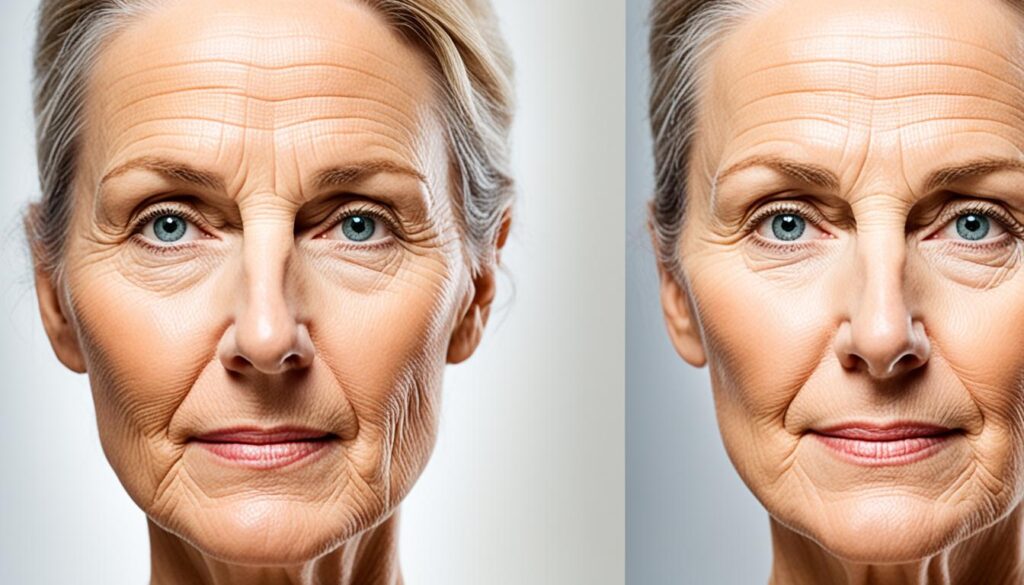
To address facial sagging at 50, there are various treatment options available. Non-surgical alternatives include liquid facelifts, which involve the use of injectable fillers to lift and tighten the facial skin. Ultherapy, a non-invasive procedure that utilizes ultrasound energy, is another effective method for rejuvenating sagging skin.
If you’re looking for more significant and long-lasting results, surgical interventions such as facelifts, necklifts, and eyelifts can provide a more comprehensive solution. These procedures help to restore the firmness and tightness of the skin, effectively reversing the effects of facial sagging.
In summary, sagging skin is a common occurrence as you age, particularly around your cheeks, jawline, and neck. However, there are various options available to address this concern and restore a more youthful appearance.
Volume Loss and Its Effects
Aging is a natural process that affects various aspects of our appearance, including the volume of our face. As we age, facial fat gradually loses volume and begins to drift downward, resulting in several noticeable effects such as hollow cheeks, hollow eyes, and loss of lip volume.
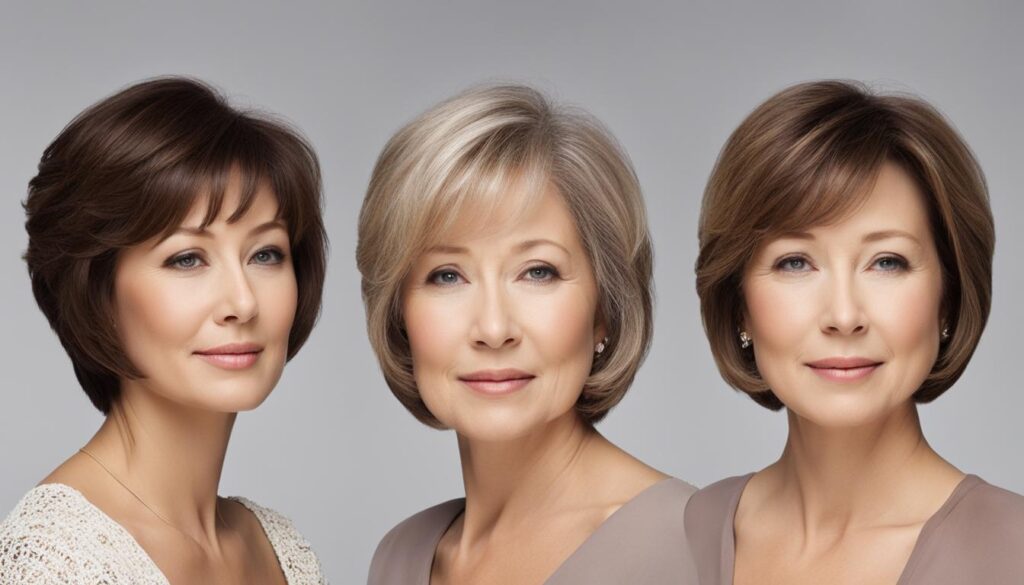
The loss of volume can give the cheeks a sunken or hollow appearance. This occurs as the fat pads in the midface begin to diminish, leading to less facial fullness. Hollow cheeks can make you look tired and gaunt, adding years to your overall appearance.
In addition to hollow cheeks, the eyes can also be affected by the loss of volume. The area around the eyes may appear hollow or sunken, creating a tired or aged look. The loss of volume can make the eyes appear smaller and less vibrant.
The lips are another area that experiences volume loss with age. Thinning lips can make you appear older and may contribute to a less youthful facial appearance. Loss of lip volume can result in less definition and a decrease in the overall fullness of the lips.
To restore lost volume and enhance facial shape, there are several cosmetic procedures available. Two common options are injectable fillers and fat transfer.
Injectable fillers
Injectable fillers work by adding volume to specific areas of the face, helping to smooth wrinkles and restore lost fullness. These fillers are typically made of hyaluronic acid, a substance that occurs naturally in the body and provides hydration and volume. Commonly treated areas include the cheeks, under-eye hollows, and lips.
Fat transfer
Fat transfer, also known as fat grafting, involves removing fat from one part of the body and injecting it into another area of the face to restore volume. This procedure is typically performed in conjunction with liposuction to harvest fat cells. Fat transfer can provide natural-looking, long-lasting results, as the body readily accepts the transferred fat.
Both injectable fillers and fat transfer procedures should be performed by a qualified and experienced cosmetic surgeon or dermatologist to ensure safety and optimize results.
Benefits of restoring facial volume
Restoring lost volume in the face can have a significant impact on your overall appearance, helping to achieve a more youthful and rejuvenated look. Some benefits of restoring facial volume include:
- Improved facial contours
- Reduction in the appearance of wrinkles and fine lines
- Enhanced cheekbones and definition
- Restoring a more youthful and plump appearance to the lips
- Overall rejuvenation and enhanced self-confidence
Skin Damage and Its Appearance
Aging, sun damage, environment, and genetics all play a role in the damage that occurs to your skin. As you reach 50, you may start to notice various signs of skin aging, including wrinkles, deep folds, blemishes, and discoloration. Additionally, your skin may appear thin and dry, further contributing to the overall aging process.
To combat these effects, it’s essential to prioritize prevention, repair, and relaxation of the skin through consistent skincare regimens and the use of topical medicines. Additionally, skin resurfacing treatments can help minimize the visible signs of skin aging.
“Aging is a natural process that affects everyone. However, taking proactive steps to care for your skin can significantly slow down the aging process and maintain a more youthful appearance.”
Skincare regimens should include cleansing, moisturizing, and protecting the skin from the sun’s damaging rays. Look for products that contain ingredients like retinol, hyaluronic acid, and antioxidants to help target specific concerns and nourish your skin.
In addition to skincare, topical medicines such as prescription retinoids can help stimulate collagen production and improve the overall texture of your skin. These medications often require a prescription from a dermatologist.
Relaxation and Resurfacing Treatments
For more advanced signs of aging, relaxation and resurfacing treatments can provide significant benefits. These treatments aim to rejuvenate the skin and address specific concerns.
- Chemical peels: These treatments involve the application of a chemical solution to the skin to exfoliate the outer layers, revealing smoother and more youthful skin underneath.
- Laser resurfacing: Laser technology is used to remove damaged skin cells and stimulate collagen production, resulting in improved skin texture and reduced wrinkles.
- Microdermabrasion: This treatment involves gentle exfoliation of the skin’s surface using fine crystals or a diamond-tipped wand, leaving your skin refreshed and rejuvenated.
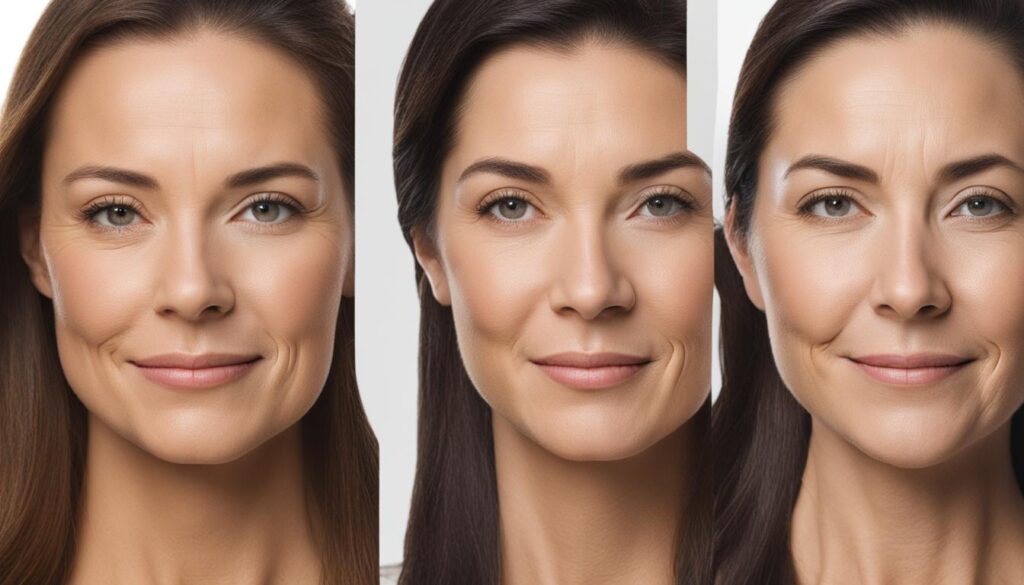
By incorporating these skincare regimens and treatments into your routine, you can minimize the appearance of skin aging at 50, including skin wrinkling and discoloration. Remember, it’s never too late to start taking care of your skin and embracing a healthier, more youthful complexion.
Aging Effects on Facial Bones
As you age, changes in your facial bones can contribute to noticeable transformations in your face. These changes involve the migration of bones, loss of mass, and alterations in angles. The resulting effects can include widening eye sockets, a drooping nose, and retractions of the jawline.
One of the prominent changes is the migration of bones, which refers to their shifting positions over time. This movement can lead to a more sunken appearance of the eyes as the bones recede and create hollowed areas around the sockets. Additionally, the nose may start to droop due to changes in its underlying bone structure.
The loss of bone mass is another common characteristic of facial aging. As you age, the gradual depletion of bone mass can contribute to a decrease in volume and support in various areas of the face. This loss of mass can further accentuate the sunken appearance of the eyes and lead to the development of hollows or indentations.
Changes in angles of the facial bones also occur with aging, which can impact the overall shape and structure of your face. The jawline, in particular, may undergo retractions as the underlying bones change positions. This can contribute to a loss of definition and contour in the lower face.
To visualize these changes, take a look at the image below:
| Facial Changes | Effects |
|---|---|
| Widening eye sockets | Creates a more sunken appearance of the eyes |
| Drooping nose | Alters the shape and position of the nose |
| Retractions of the jawline | Contributes to a loss of definition in the lower face |
These changes in facial bones can significantly impact your overall facial appearance. While they are a natural part of the aging process, there are various options available to address these effects and achieve facial rejuvenation.
In the next section, we will explore the changes in facial muscles and how they contribute to facial sagging.
Muscle Changes and Facial Sagging
As you reach your 40s and 50s, you may notice changes in your facial appearance, particularly in the form of sagging cheeks and droopy eyelids. These changes are primarily caused by alterations in your facial muscles.
Facial muscles, like any other muscles in your body, lose volume, strength, and elasticity over time. The laxness of these muscles and the loss of muscle mass contribute to the sagging of cheeks and the drooping of eyelids. Additionally, muscle weakness can also result in the development of a “turkey neck,” where the muscles in the neck become loose and cause sagging.
To better understand the impact of muscle changes on facial sagging, it’s essential to recognize that your facial muscles play a vital role in supporting the overlying skin and tissues. With age, the diminished volume and loosening of facial muscles can no longer provide the necessary support, resulting in the appearance of sagging skin and droopy features.
Fortunately, there are various treatment options available to address muscle-related facial sagging. Non-surgical treatments such as facial exercises, facial massage, and facial yoga can help strengthen and tone the facial muscles, promoting a more lifted and youthful appearance. Additionally, certain cosmetic procedures like facelifts and brow lifts target specific areas of muscle laxity, providing a more comprehensive solution to facial sagging.
Remember that achieving optimal results relies on consulting with a qualified healthcare professional or plastic surgeon who can provide personalized recommendations based on your specific needs and expectations.
In the next section, we will explore another crucial aspect of aging: fat redistribution and its effects on facial appearance.
Fat Redistribution and Its Effects
As you age, the distribution of fat in your face undergoes changes, leading to various effects on your appearance. One common effect is the redistribution of facial fat, which tends to shift downward. This can result in the formation of jowls around the chin and jawline, as well as the development of a double chin.
The process of fat redistribution in the face is influenced by factors such as genetics, hormonal changes, and lifestyle habits. As the underlying layer of fat in your face diminishes, the skin becomes thinner and more translucent. This can enhance the visibility of fat clumping in the lower face, contributing to the appearance of jowls and a double chin.
To illustrate the effects of fat redistribution, here’s a visual representation:
| Effects of Fat Redistribution |
|---|
| Jowls around the chin and jawline |
| Double chin |
| Increased visibility of fat clumping in the lower face |
To address the effects of fat redistribution and restore a more youthful facial appearance, there are various treatment options available. These include non-surgical procedures such as injectable fillers, which can add volume and contour to the face, and surgical procedures like facelifts or neck lifts, which can tighten sagging skin and redefine the jawline.
Consulting with a board-certified plastic surgeon will allow you to explore the most suitable treatment options for your specific concerns and desired results.
Changes in Specific Facial Features
Aging can bring about noticeable changes in specific facial features, including the eyes, lips, and nose. These changes are a natural part of the aging process and can contribute to an overall change in facial appearance.
Eyes: Heavy and Tired Appearance
As you reach the age of 50, you may start to notice changes in your eyes. The eyelid skin may begin to loosen, causing the eyes to appear heavy and hooded. Additionally, the muscles around the eyes may stretch, leading to a tired and fatigued look. In addition, the loss of fat around the eyes can cause a sunken appearance. These changes can contribute to an overall aging appearance.
Lips: Loss of Tone and Plumpness
Over time, the lips can also undergo changes as you reach the age of 50. The lips may lose their natural tone and plumpness, resulting in a thinner appearance. Fine lines and wrinkles may also develop around the lips, causing a loss of definition. These changes can affect the overall youthful look of the face.
Nose: Drooping and Changes in Size
The nose is another facial feature that can be affected by the aging process. As facial volume diminishes with age, the nose may start to droop and collapse at the sides. This can lead to a change in the size and shape of the nose, with it appearing bigger and wider. These changes in the nose can contribute to an overall alteration in facial symmetry and balance.
Understanding the changes that occur in specific facial features can help you make informed decisions about skincare and cosmetic procedures, should you choose to address these concerns. It’s important to consult with a qualified professional who can provide personalized recommendations based on your unique needs and desired outcomes.
| Facial Feature | Changes at 50 |
|---|---|
| Eyes | Heavy and tired appearance due to eyelid skin looseness, muscle stretching, and fat loss |
| Lips | Loss of tone and plumpness, development of fine lines and wrinkles |
| Nose | Drooping, collapse at the sides, and changes in size |
Conclusion
Facial aging is a natural process that affects everyone as they get older. However, there are effective options available for facial rejuvenation that can help reverse the signs of aging and restore a more youthful appearance. Whether you prefer non-surgical treatments or are considering plastic surgery, there are solutions to address your concerns.
Non-surgical treatments like botulinum toxin (Botox) and dermal fillers can target specific areas of concern such as fine lines, wrinkles, and loss of volume. These minimally invasive procedures provide quick results with little to no downtime, allowing you to refresh your look and boost your confidence.
For individuals looking for more comprehensive results, surgical procedures like facelifts can address multiple signs of facial aging in one go. A facelift can tighten sagging skin, smooth out deep wrinkles, and lift the underlying tissues, resulting in a more youthful and rejuvenated appearance.
When it comes to making decisions about your facial rejuvenation journey, it’s crucial to consult with a board-certified plastic surgeon. They can assess your unique concerns, explain the various treatment options available, and guide you towards the most suitable approach to achieve your desired results.

